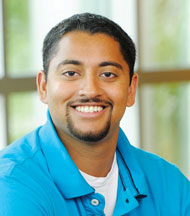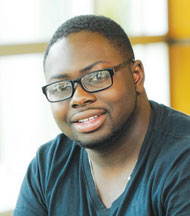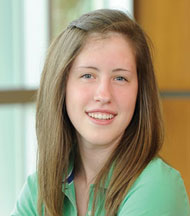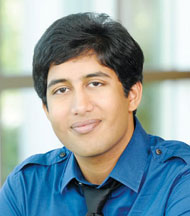UAB's Phage Genomics Explorations Program Gives Students a Head Start
By Caperton Gillett
|
Thanks to an intrepid band of UAB freshmen and sophomores, the world now knows of the existence of OSmaximus and BengaliBalla92. The students discovered and named the two bacteriophages—viruses that infect bacteria—in their first college biology class. Unlike most introductory undergraduate biology courses, which use lectures to begin teaching about research, the new UAB Phage Explorations Program puts students in the lab on day one. There they learn scientific protocols and techniques as they experience the thrill of discovery.
The UAB Phage Explorations Program was established in 2010 with the support of a Howard Hughes Medical Institute (HHMI) Science Education Alliance grant. At UAB, the Phage Explorations research team is led by Denise Monti, Ph.D., M.P.H., an instructor in the Department of Biology. Sixteen UAB students—eight freshmen and eight sophomores—were selected to participate in the research-intensive course. Naming Rights
In the lab, the students worked independently under the eyes of their mentors. “When you’re in a lab-based class, you have protocols set out for you. You’re told what to do,” says Ahmed, who identified and named BengaliBalla92. He had prior research experience from high school, he says, but appreciated the opportunity to go straight into the lab on the first day of his freshman year. “This is more like an experimental lab. It’s more spontaneous, because anything can happen. You might have to make your own protocol when certain things arise in the experiment.”
“It’s not just following protocol. Things don’t always go right,” Alakija says. He says his experiences working with phage genomics prepared him for his current work in the lab of Louis Dell’Italia, M.D., a UAB professor of medicine and cardiovascular disease researcher. “That’s how it is in a real research lab. Things don’t go right. You can’t waste the day—you have to just keep going and figure things out.” Computer ScienceThe students don’t spend all of their time toiling over an electron microscope. They also toiled over their computers, learning to write research papers and grant proposals. Students even presented research proposals before a mock review board, Thomas says. “We get a holistic view of everything that goes on in the world of research. We do everything you think of when you think about research—working with plates, using pipettes. But then we go through the process of asking, ‘How do you actually get funding for a research project like this?’”
Thomas hopes to continue researching throughout his college career and then go to medical school, and Dunkerley intends to do the same until she becomes an occupational therapist. As for Ahmed and Alakija, both students plan to study basic science and clinical science for an M.D./Ph.D. or M.D./M.P.H. and careers in translational medicine. “It definitely solidified my research background and cemented my plans for the future, wherever I go,” Ahmed says. “If I ever submit a paper to be published, I’ll know how to write it at a level that could be accepted by scientific journals, and I know that medical schools look highly on research and endeavors in academics.” Alakija, who wants to conduct further research with Dell’Italia, says that merely being selected for the program was enough to motivate him and excite him about his chosen career. “I thought, ‘I must be doing pretty well. They must see something in me.’ It gave me the confidence to talk to mentors, use my skills, and get right into it.” |



